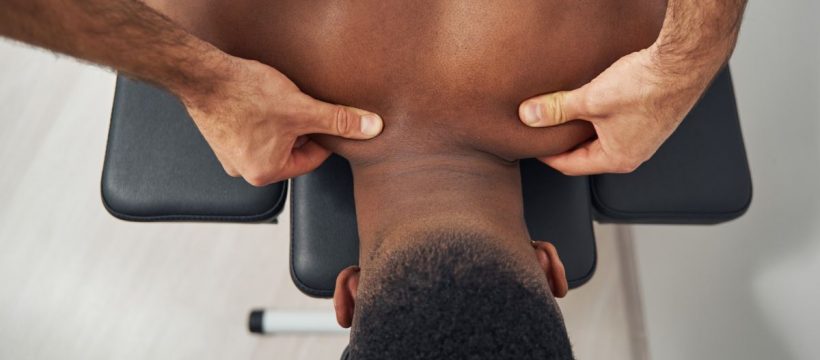If you’re searching for relief from tight muscle knots, a trigger point massage could be just the solution. Targeting knots or ‘trigger points’ in your body, a trigger point massage helps to soothe tightness and relieve pain.
Knots tend to form due to repetitive strain or overuse of particular muscles. So if you spend most of your day slouched at a desk or have been ramping up your training lately, a trigger point massage is a fantastic way to ease sore muscles.
Performing a trigger point massage yourself is a convenient way to get relief from the comfort of your home, and ideal if you have a busy schedule. Not sure where to start? We asked the experts to explain the science behind trigger point massage and suggest some simple tips for performing one on yourself.
What is a trigger point massage?
According to the American Massage Therapy Association, trigger points are sensitive, sore spots where the bands of muscle fibers have become tight and contracted. They’re generally near nerve endings, which is why you may feel pain, and are thought to form due to muscle overuse which prevents effective recovery. People who engage in repetitive movement are also more prone to trigger points which explains why they’re common in both sedentary populations and runners. But what is a trigger point massage?
“This is a massage technique that targets localized tender or hyper-irritable spots in the muscles,” says Louise Richardson, Regional Clinical Lead at Total Physiotherapy. “Trigger point massage works to relieve pain and tension in these areas through isolated pressure and release.”
You can perform a trigger point massage using your hands or you can enlist the aid of tools like small foam rollers, tennis balls, and massage guns.
What does a trigger point massage do?
“The aim of trigger point therapy is to restore normal function of the muscle and surrounding area,” explains John Holman, Director of Massage Training at The Massage Company. “It does this by releasing the area of hyper-irritability and soothing the surrounding tissue.”
Curious about what’s going on beneath the surface? Richardson explains that applying pressure increases circulation to the area. “As fresh, oxygenated blood is pushed in, waste material is flushed out, which allows the muscle fibers to relax and provides some pain relief,” she adds. As well as soothing pain, Richardson says a trigger point massage can be helpful in aiding recovery from an injury and that a focus on the neck, shoulders and back can promote good posture.
You may also hear about trigger point massage as a treatment for referred pain. Pain can either occur at the site of the knot or radiate to another area of the body. A headache, for example, may be referred pain from a knot in your neck. In this instance, massaging the knot in the neck could potentially alleviate headache symptoms.
“The therapist knows that the trigger point will often refer pain away from the site and will use massage and stretch techniques to affect those areas,” says Holman.
While the experts agree that trigger points exist, how they work and the extent to which the benefits are proven is the subject of debate. One 2015 paper criticized a lack of evidence behind the theories, while another 2018 study showed that trigger point massage reduced pain associated with tension headaches. While scientific understanding is still emerging, the only way to know whether it works for you is to try it.
How to perform a trigger point massage
Ready to give trigger point massage a go? We asked the experts for a step-by-step guide to help you perform a trigger point massage at home. While not a substitute for an appointment with a professional, it can be a great way to keep on top of knots in between appointments.
The key is starting small and building up slowly. You may be all too aware of a knot, in which case begin by massaging that area. If you’re not sure where to begin, give yourself a whole-body massage and pay attention to sore spots, as this is a sign of a trigger point.
When you’ve identified your target, massage the spot gently at first, allowing the muscles to warm up. Richardson advises using fingers or thumbs, and pressing directly on the trigger point until the pain begins to diminish. “You can also apply small, kneading strokes, either circular or back and forth, to increase blood flow to the area,” she says. “Alternate between light and firmer pressure.” Alternatively, you can use nifty tools like a tennis ball or a massage gun, which do the work for you.
Build up the pressure slowly without reaching a point where it becomes unbearable. According to Richardson, you should expect to feel some discomfort in the area, but too much intensity can be counterproductive, so err on the side of caution. Avoid the temptation to massage a trigger point for longer than five minutes. If you overdo it, you could end up feeling sore.
To reap maximum benefits, you’ll want to stay hydrated before and after the massage. This flushes out any toxins and waste products. Take it easy after your massage too and don’t forget to prioritize a good night’s sleep.
Louise Bond
Louise Bond is a UK-based writer specializing in health and wellbeing. She has over eight years of experience in management within health and care and brings this passion and expertise to her writing. Louise has been published in The Guardian, Planet Mindful and Psychreg among others. She is at her happiest when she is out in nature, whether that’s on an invigorating hike or pottering in the garden.
Source: Read Full Article

